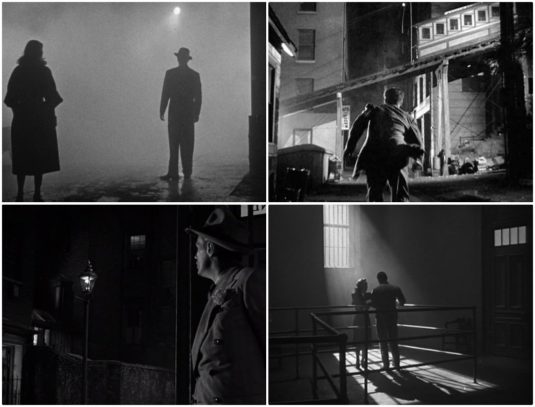
The film noir style: clockwise, The Big Combo (1955), Act Of Violence (1949), The Phantom Lady (1944), Night and the City (1950)
Classic American film noir was a film cycle in tune with its time: it fulfilled a need of a considerable part of film going audiences (especially after the end of WWII) for less film escapism and more mature, reality-based cinema.
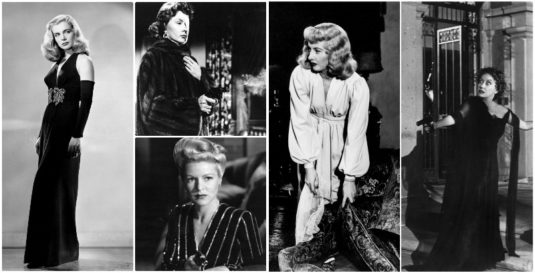
Lizabeth Scott, Gloria Grahame, Claire Trevor, Barbara Stanwyck & Gloria Swanson, in fulll femme fatale mode (Publicity stills composition by Despina Veneti)
The action can take place anywhere. What helps us recognize a film noir is its distinctive visual style and a certain ethos as relevant today as ever (moral ambiguity, alienation, anxiety, existential agony). As diverse as its milieu is film noir's olfactory stamp: gunpowder, blood, sweat, night club atmosphere filled with cigarettes and booze, the city's underbelly smell of cheap restaurants, burnt tires and garbage cans, fresh night air, or men carrying rose-scented handkerchiefs and gardenia-scented calling cards (to indicate homosexuality). And of course the alluring fragrant trail of five film noir femmes fatales…
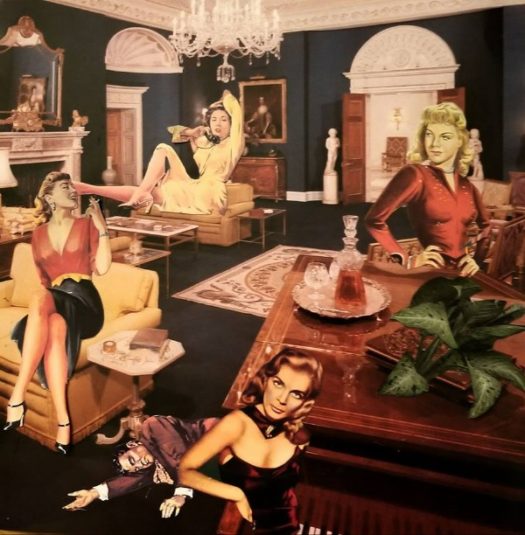
Femmes Fatales of Film Noir/ Collage art by Jackie Jones© (Instagram: @kitschgirl)
These characters are enchantress who lure the (anti)hero to a dangerous, often lethal path. However, the most memorable femmes fatales always have psychological depth, even a hint of trauma, abuse, or simply repression by a hopelessly male-dominated society. What follows is a selection of five female characters, and their imagined perfume.
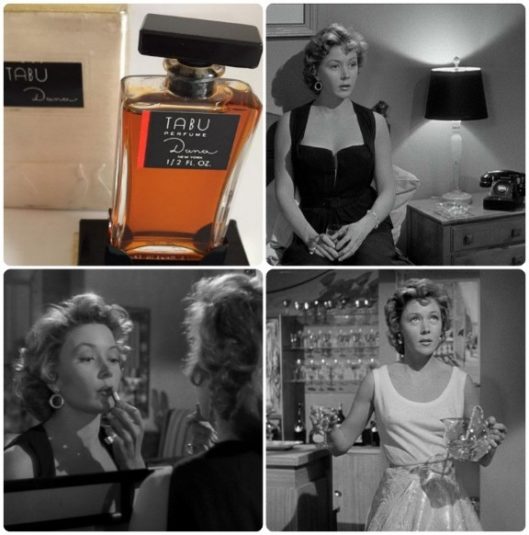
Dana Tabu & Gloria Grahame as Debby in The Big Heat (1953) (Copyright: Columbia Pictures/Sony Pictures Home Entertainment)
Gloria Grahame as Debby Marsh in The Big Heat (1953)/ Dana Tabu: In Fritz Lang’s film noir, homicide sergeant Bannion (Glenn Ford) tries to avenge his wife's murder by exposing the syndicate chief behind it. In his quest for justice he comes across Debby, girlfriend of sadistic henchman, Vince (Lee Marvin). Debby is seen talking to Bannion, triggering Vince’s psychotic rage: he disfigures half of her face with scalding hot coffee…Debby is an apparent film noir femme fatale, who ends up redeeming herself. Before her disfigurement, she seems content to be a luxury-loving gun moll, willing to take an occasional beating from her violent lover. However, she is also witty and recklessly outspoken.
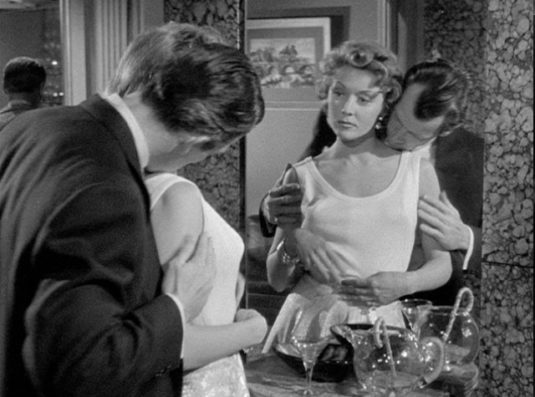
Gloria Grahame & Lee Marvin – “It attracts mosquitoes and repels men…” (Copyright: Columbia Pictures/Sony Pictures Home Entertainment)
In the film’s perfume-related scene (the still intact) Debby admires herself narcissistically in the mirror, while Vince approaches her clearly excited by her perfume; she tells him that the scent “attracts mosquitoes and repels men”. When he points out that it didn't work that way on him, she answers: “it's not supposed to” – an insult too clever for him. I imagine Debby wearing Dana Tabu, the 1932 Jean Carles creation that screamed “seduction”, still popular in early 50s. Story has it that Carles was asked to create a “perfume for whores”, but in its vintage form, Tabu was a sensational oriental composition of jasmine, rose and ylang-ylang all warmed up by amber, woods and civet – a potent aromatic potion for women unafraid to declare their sexuality. Just like Debby.
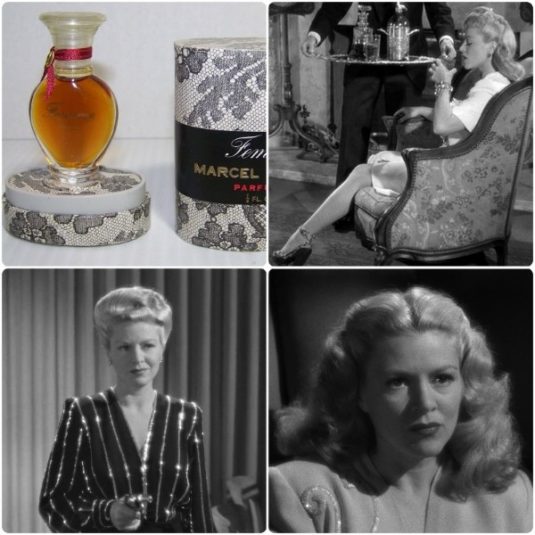
Rochas Femme & Claire Trevor as Velma in Murder, My Sweet (1944) (Copyright: RKO Radio Pictures/Warner Home Video)
Claire Trevor as Velma/Mrs. Grayle in Murder, My Sweet (1944) /Rochas Femme: Edward Dmytryk's film noir adaptation of Raymond Chandler finds P.I. Philip Marlowe (Dick Powell) in a complicated case that starts with locating Velma, an ex-jailbird’s girlfriend. After a series of dead bodies, a case of a missing jade necklace, and his encounter with the young Ann (Anne Shirley), he will find out that Velma is now Mrs.Grayle, married to Ann's rich father, and suspect for all these crimes… Velma is a sleek and colorful villainess. Fabulously dressed and coiffed, sharped-tongued, sexually forward, and extremely amusing, she could be every man's dream – if only she could be trusted! The film is filled with smelling moments; Marlowe trusts his sense of smell more than his own eyes: he constantly sniffs objects, drinks and food, and when he gets temporarily blinded he recognizes Ann by her fragrance.
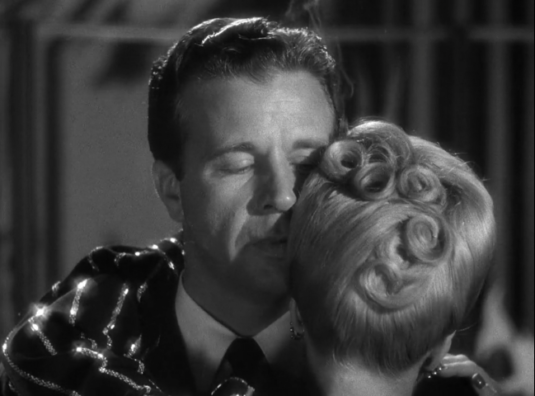
Marlowe (Dick Powell) getting a sniff of Velma’s perfume (Copyright: RKO Radio Pictures/Warner Home Video)
His keen sense of smell will also detect Velma’s perfume, which he describes as “nice, expensive smell”. Perhaps Velma is wearing the latest imported sensation from Paris, Edmond Roudnitska's 1944 Femme for Rochas, which could have been afforded by a woman married into wealth, with a taste for the newest, most fashionable and expensive. This sumptuous chypre combined a rich bouquet (rose, jasmine, ylang-ylang, violet) with delicious fruit notes (peach, prune) and spices (cumin, cloves). Oakmoss, musk and amber completed one of the first post-WWII fragrant masterpieces. Its classy opulence, curvaceous bottle and emblematic name would certainly have attracted this femme fatale.
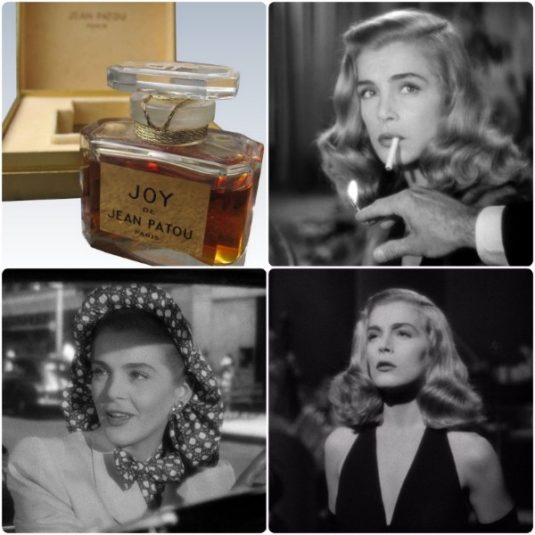
Jean Patou Joy & Lizabeth Scott as Coral in Dead Reckoning (1947) (Copyright: Columbia Tri-Star/Sony Pictures)
Lizabeth Scott as Coral “Dusty/Mike” Chandler in Dead Reckoning (1947)/Jean Patou Joy: In John Cromwell's film noir, Rip Murdock’s (Humphrey Bogart) investigation for the disappearance of his army buddy leads him straight to his friend's old flame, Coral Chandler. A nightclub canary that looks like a “Cinderella with a husky voice”, Coral casts her spell on Rip with her charms and her jasmine-dominated perfume, on which he seems to be fixated.
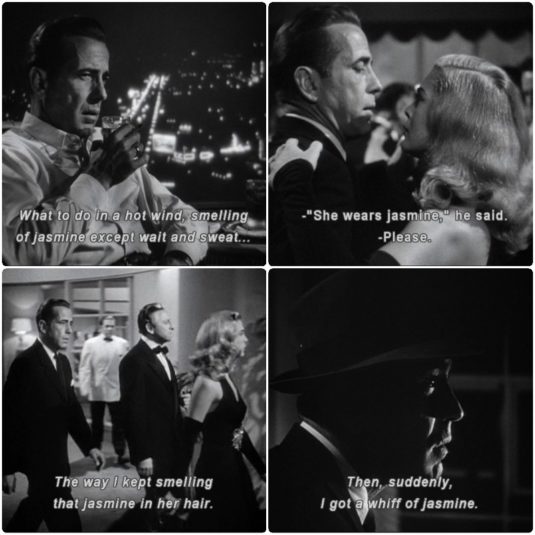
Jasmine-obsessed Rip (Humphrey Bogart) (Copyright: Columbia Tri-Star/Sony Pictures)
He falls hard for her, but as they plan to skip town together he discovers she is involved in the circumstances surrounding his friend’s death, along with a gambling joint operator. Her very fragrance will actually give Coral away: Rip recognises her jasmine scent where it shouldn't have been…
A fancy doll like Coral, with a clear taste for all the finest things life has to offer, could have certainly picked the “costliest perfume in the world”, Jean Patou Joy, created in 1930 by Henri Alméras. The famous jasmine-rose classic (with the prominent jasmine in unprecedented concentration), warmed up by civet, was still at the time (and for several decades after) a favorite of many affluent women, including those who chose it a symbol of insolent luxury and much needed sophistication. The extraordinary sillage described in the film is also consistent with vintage Joy’s amazing performance.
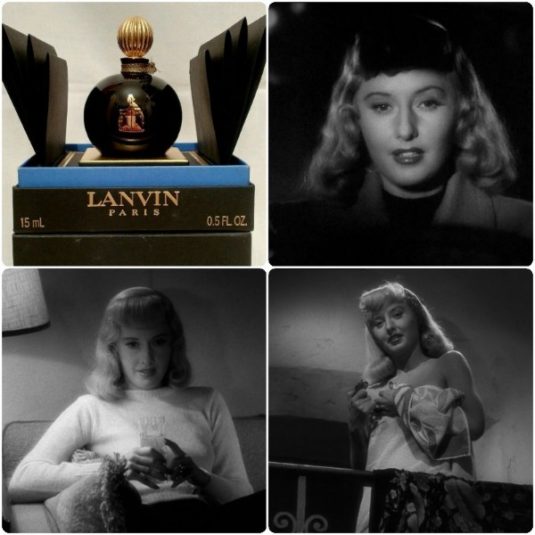
Lanvin Arpège & Barbara Stanwyck as Phyllis in Double Indemnity (1944) (Copyright: Paramount Pictures/ Universal Pictures Home Entertainment)
Barbara Stanwyck as Phyllis Dietrichson in Double Indemnity (1944)/ Lanvin Arpège: In Billy Wilder’s film noir adaptation of James M. Cain, smooth-talking insurance salesman Walter Neff (Fred MacMurray) meets sexy Phyllis Dietrichson (Barbara Stanwyck) when he tries to renew her husband's car policy. Phyllis will try to have a life insurance policy for her husband without him knowing. Experienced Walter will at once recognise her murderous intentions. But after her night visit to his home he will fully agree to assist her. Phyllis Dietrichson is a seductress with platinum blonde hair, body-clinging outfits, and a sensual voice. She serves Walter a story about her husband being cruel, stingy, even physically abusive. But it's really the (implied) sex that does the trick for him. In his voice-over, Walter recounts the excitement after having just met her: “how could I have known that murder can sometimes smell like honeysuckle?”; he's talking about the street trees, but he could also be referring to a prominent note in Phyllis’ perfume, which he had earlier admired.
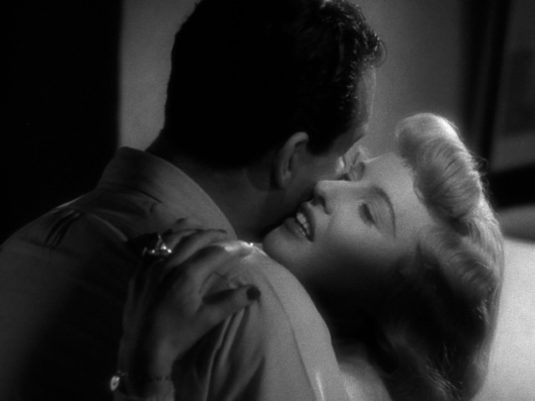
Fred MacMurray & Barbara Stanwyck – “You ought to have some of that pink wine to go with it…” (Copyright: Paramount Pictures/ Universal Pictures Home Entertainment)
When Phyllis seduces him into aiding her, her perfume is again fundamental. Intoxicated by it, Walter says: “you ought to have some of that pink wine to go with it, the kind that bubbles”. I imagine Phyllis wearing Lanvin Arpège, the 1927 André Fraysse/Paul Vacher creation. Its champagne-like sparkliness is a result of the explosive combination of the aldehydes with a bergamot, peach, orange blossom and neroli opening, while in its heart lies a rich bouquet (rose, jasmine, tuberose, violet, even honeysuckle), warmed up by vetiver, patchouli, vanilla and musk. Arpège’s standout opaque black bottle would have easily captured this black widow's attention.
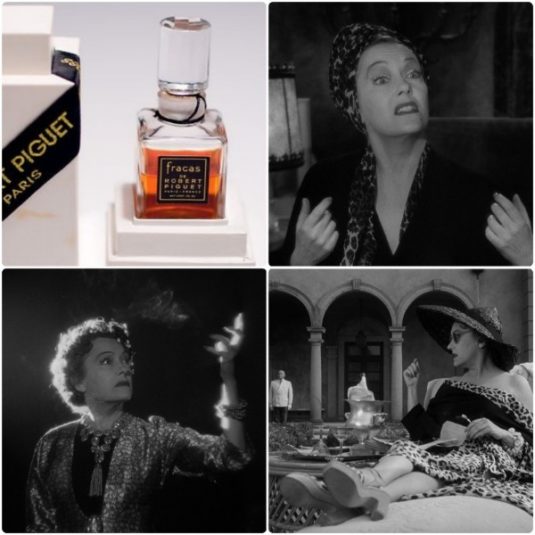
Robert Piguet Fracas & Gloria Swanson as Norma in Sunset Blvd. (1950) (Copyright: Paramount Pictures)
Gloria Swanson as Norma Desmond in Sunset Blvd. (1950)/ Robert Piguet Fracas: Hunted by creditors, failed screenwriter Joe Gillis (William Holden) takes a fateful turn on Sunset Boulevard, leading to a sinister mansion – home of secluded, aging silent film star, Norma Desmond (Gloria Swanson). Desperate to make some cash, Joe will manipulate her into hiring him to “polish off” the hopeless script she wrote. Soon they will become lovers. When Joe falls in love with young script girl Betty (Nancy Olson), Norma's jealousy will escalate into madness. Billy Wilder's baroque film noir is structured on contrasts: gritty drama and black humor; Norma’s musty, decaying mansion in the heart of sunny, breezy Hollywood; the demanding, imperious Norma and the fresh, wholesome Betty. Femme fatale extraordinaire Norma Desmond is herself a woman of contrasts: passionate, spirited, but also mercurial, self-destructive, and demented.
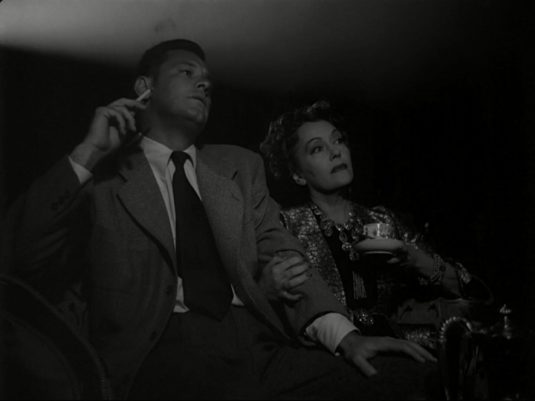
William Holden & Gloria Swanson – “She’d sit very close to me, and she'd smell of tuberoses…” (Copyright: Paramount Pictures)
Contrary to what's often mentioned, Norma neither caresses a bottle of Caron Narcisse Noir, nor utters its name in the movie. This film noir has an actual perfume clue that comes when Norma and Joe watch one of her old films, with him remarking in voice-over: “She'd sit very close to me, and she'd smell of tuberoses, which is not my favorite perfume, not by a long shot”. Her overpowering perfume is contrasted to Betty's simple shampoo smell, which Joe seems to prefer. Norma would be wearing Germaine Cellier’s Fracas, created in 1948 for Robert Piguet. This tuberose-overdose classic features many other heady white flowers (jasmine, white narcissus, gardenia, lily of the valley, white iris), resting in a warm bed of musk, sandalwood, oakmoss, orris, and vetiver. It soon became popular in America, and by 1950 it must have been flooding Hollywood gatherings (which could explain why Wilder has Gillis express a distaste for it!). Fracas (French for “uproar”) may indeed be dramatic and wild at “hello”, but its creamy, sensual drydown reveals a tender heart. Like Norma’s spirit in a bottle.
– Despina Veneti, Sr. Contributor
